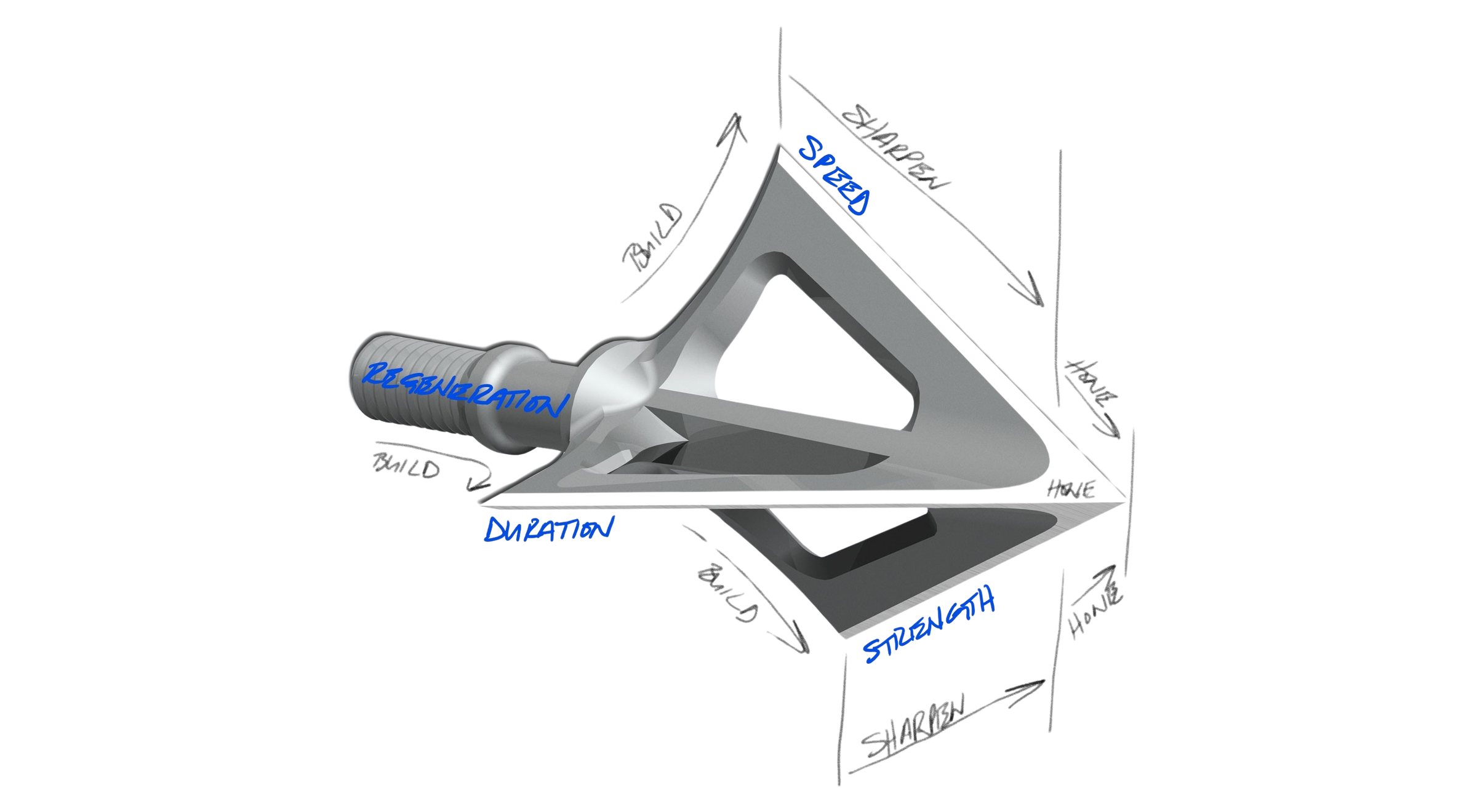What is Arrowhead Endurance?
Arrowhead Endurance is a planning method that develops multiple training factors concurrently by starting at the extremes and progressing each component toward a goal pace using converging periodization.

Modern training is multi-dimensional. Using just "volume and intensity" without a specific purpose will fall short of developing an athlete's full potential.
Arrowhead Endurance is:
a planning method
Periodization is planning what type of training to focus on when throughout a macrocycle.2 Training components are planned well in advance—typically over months and, with big goals, years—using macrocycles and mesocycles.
For an annual routine, I like to use:
- Two 26-week macrocycles per year each split into two 13-week blocks; and
- Mesocycles of 12 weeks for capacity, eight weeks for power, four weeks to peak, and two weeks for performance and recovery.
that includes multiple training factors
The "big four" training factors are strength, speed, duration, and execution. These are obviously not unique to Arrowhead Endurance, but the approach to training them has some subtle differences.
- Strength is often neglected by endurance athletes, and especially by mountain athletes. The idea is to increase muscle fiber recruitment with very high loads and then train the new recruits to work aerobically.3
- Speed is often under-developed. Rarely do endurance athletes work above race pace or anaerobic threshold, especially those that are training for long-duration events. There are benefits to working well above those paces.4
- Duration is more widely applicable than distance. When terrain is predictable (i.e. in road running), then distance and pace is enough to inform training. But when terrain is variable or unpredictable, duration is a better metric.4
- Execution is often neglected, especially in cyclic sports like running and cycling. But significant gains can come from becoming more efficient by pruning wasteful movement patterns.
and trains them concurrently
Unlike traditional periodization, converging periodization progresses all four training factors at the same time throughout a macrocycle rather than in sequence. Nothing is left behind.5
by starting at the extremes
The "arrowhead" in converging periodization starts with each component at its maximum effective intensity. (See the diagram at the top of this post.)
- Strength starts maximal, slow, and low volume.
- Speed starts maximal, short, and low volume.
- Duration starts at maximal effective—not absolute maximum—slow, and high volume.
- Execution starts messy, slow, and high volume. As the mess disappears, speed increases with stress.6
and progressing each component
Unless there are unplanned breaks (from illness, injury, or interference), workouts should always progress and rarely repeat.7
- For strength: As loads decrease, speed and volume increase;
- For speed: As speeds decrease, duration and volume increase;
- For duration: As duration decreases, speed increases and volume decreases; and
- For execution: As technique improves, speed and stress increase and volume decreases.
A changing stimulus will prolong adaptation, but it has to be structured. Random stimuli will not maximize performance for specific goals.
toward a goal event.
The business end of the "arrowhead" is determined by the combination of factors required to perform in a goal event at a goal pace at a specific time in the future. To get the best performance, every factor must be goal-ready at the same place and time.
But special attention has to be paid to the different demands of different events and the athlete pursuing them:
- A marathon is flat, 42.2 kilometers, and largely steady state. But running it in two, three, or four hours makes for three different events with equally different demands.
- A typical skimo race is 15 km and 1600m of vertical gain. But different durations will determine sustainable output levels. A two-hour race will average below anaerobic threshold with several surges above. A four-hour race will likely stay well below.
- The Presidential Traverse demands a sustained climb of 1200m over 6 km, a rolling ascent (up 960m, down 620m) over 9.5 km, a rolling descent (up 250m, down 880m) over 8.2 km, and then a pounding descent of 720 m over 4.7 km. A sub-4-hour FKT will probably average around aerobic threshold while an all-day hike will be far below.
A "goal event" is not just a bucket list item scratched on a calendar. It also has to take into account the athlete that wants to attempt it, the difference between current and desired fitness, and how to bridge that gap.
- I didn't invent converging periodization, but I did create the term. Other adjectives you may hear are "funnel" or "mixed" periodization. For me, those aren't descriptive enough.
- Traditional periodization is linear. It starts with a focus on long, easy sessions and gradually progresses to shorter and faster as the athlete moves through a macrocycle. It leaves a lot of low-hanging fruit unpicked. Converging periodization is more sophisticated. It includes linear periodization, but as only one piece of the puzzle.
- For strength work, a key influence was Yuri Verkhoshansky’s Special Strength Training for Coaches.
- Renato Canova’s ideas and programs on developing both speed and duration created many big “aha!” moments. The trick was converting pace and distance to usable intensities for variable terrain. And translating Engli-talian.
- Steve Magness’ The Science of Running is a great summary of modern training theory and practice. “Nothing left behind” is a key concept.
- Note that messy execution only applies to sport-specific movements. Strength work, especially maximal work, demands proper execution at all times.
- But training progressions have to follow the athlete, not the other way around. Jan Olbrecht’s “steering principle” from The Science of Winning is essential.